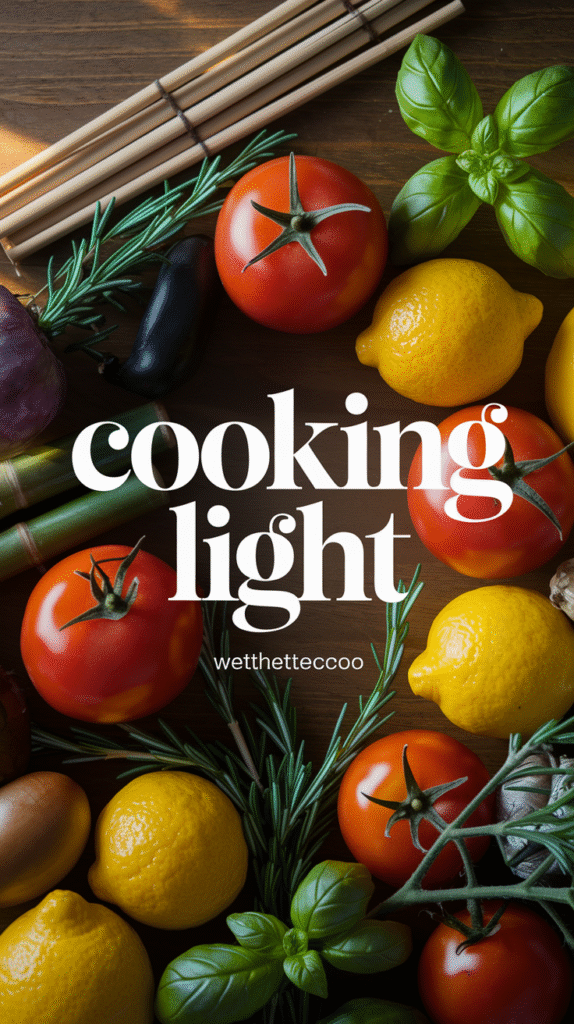Incorporating cooking light into your daily routine offers a pathway to healthier eating while still savoring delicious meals. By focusing on lighter cooking methods, you can significantly enhance the nutritional quality of your meals without sacrificing flavor or enjoyment. Below are the benefits you can gain by embracing this approach.
Health Benefits of Cooking Light
Transitioning to lighter cooking techniques brings numerous health benefits. These advantages can lead to better overall well-being and a more vibrant lifestyle:
- Weight Management: Dishes prepared with less fat and fewer calories help control weight. By reducing heavy sauces and fried foods, you can enjoy satisfying meals that won’t add unwanted pounds.
- Reduced Risk of Chronic Diseases: Eating lighter can contribute to lower risks of heart disease, diabetes, and hypertension. Cooking methods like steaming, grilling, and baking retain nutrients and minimize unhealthy fats.
- Improved Digestion: Lighter meals often include more vegetables, making them rich in fiber. This can promote better digestion and avoid issues like bloating and constipation.
- Increased Energy Levels: Wholesome meals that are easier to digest can lead to increased energy and vitality. Choosing lighter options allows you to stay active and energized throughout the day.
Techniques to Enhance Cooking Light
While the goal is to reduce calories, the taste should never be compromised. Here are some effective techniques to ensure your meals remain delicious:
- Steaming: This method preserves the vitamins in vegetables. Steamed vegetables retain their vibrant colors and flavors while staying low in calories.
- Grilling and Roasting: Use these methods to enhance the natural flavors of meats and vegetables. They require less fat, resulting in tasty dishes that are also lighter on calories.
- Sautéing with a Twist: Use vegetable or chicken broth instead of oil for sautéing. This keeps the dish light while still adding depth to the flavors.
- Fresh Herbs and Spices: Boost flavor without extra calories by incorporating herbs and spices. They add a punch of taste that will overshadow the need for heavy sauces.
Benefits of Meal Prepping with Light Cooking
Meal prepping can simplify your cooking routine. By planning your meals, you can ensure you eat healthier consistently. Consider these advantages:
- Time-Saving: Preparing meals in advance allows you to save time during busy weekdays.
- Portion Control: Pre-portioning meals helps maintain healthy serving sizes, reducing the temptation to overeat.
- Less Food Waste: With a plan in place, you’ll use ingredients more efficiently, minimizing leftovers that may go uneaten.
Recipes to Get Started with Cooking Light
Here are a few delicious, lighter recipes that you can try at home:
| Recipe Name | Main Ingredients | Cooking Method |
|---|---|---|
| Zucchini Noodles with Marinara | Zucchini, tomatoes, garlic, basil | Spiralize and sauté |
| Grilled Lemon-Herb Chicken | Chicken breast, lemon juice, herbs | Grilling |
| Quinoa Salad | Quinoa, cucumbers, cherry tomatoes, feta | Mix and serve cold |
Incorporating cooking light into your diet doesn’t have to be overwhelming. Start small, experiment with new recipes, and gradually make lighter choices that suit your palate. By choosing lighter methods and meals, you’re not only improving your health but also enjoying the process of cooking. For more inspiration on healthy cooking, check out Cooking Light.
With a commitment to cooking light, you open the door to a wealth of flavors and health benefits. Begin today and transform the way you think about food and nutrition.
Creative Cooking Light Recipes for Busy Weeknights
Busy weeknights often leave little time for elaborate meals, but that doesn’t mean you have to settle for dull or unhealthy food. Creative cooking light recipes can be the perfect solution to make your evenings enjoyable, delicious, and nutritious. Here are some delightful options that cater to your appetite without overwhelming your schedule.
One-Pan Zucchini Noodles with Shrimp
This dish is packed with flavor and comes together in just 20 minutes. Spiralize fresh zucchini to make noodles, and sauté them with juicy shrimp, garlic, and cherry tomatoes for a refreshing and light dinner.
- Ingredients:
- 2 medium zucchinis
- 1 pound shrimp, peeled and deveined
- 2 cups cherry tomatoes, halved
- 2 cloves garlic, minced
- Olive oil
- Salt and pepper to taste
- Directions:
- Spiralize the zucchinis into noodles.
- In a skillet, heat olive oil over medium heat.
- Add garlic and shrimp, cooking until shrimp is pink.
- Add zucchini noodles and tomatoes, sautéing for an additional 3-5 minutes. Season to taste.
Quinoa and Black Bean Bowl
If you need something hearty yet light, this quinoa and black bean bowl is a fantastic choice. It’s easy to prepare in bulk and offers an excellent source of protein and fiber.
- Ingredients:
- 1 cup quinoa
- 2 cups vegetable broth
- 1 can black beans, rinsed
- 1 cup corn
- 1 avocado, diced
- Fresh cilantro for garnish
- Lime wedges
- Directions:
- Rinse quinoa under cold water.
- Cook quinoa in vegetable broth according to package instructions.
- In a bowl, combine cooked quinoa, black beans, and corn.
- Top with diced avocado and fresh cilantro. Serve with lime wedges.
20-Minute Chicken Stir-Fry
This quick chicken stir-fry packs a punch with vibrant veggies and a savory sauce. It’s perfect for busy weeknights and comes together in just 20 minutes.
- Ingredients:
- 1 pound chicken breast, sliced thin
- 2 cups mixed bell peppers, sliced
- 1 cup broccoli florets
- 2 tablespoons soy sauce
- 1 tablespoon cornstarch mixed with water
- 2 tablespoons sesame oil
- Directions:
- Heat sesame oil in a pan over medium-high heat.
- Add chicken and cook until browned, about 5 minutes.
- Add the vegetables and continue cooking until tender.
- Pour in soy sauce and cornstarch mixture, stirring until thickened.
Cilantro Lime Rice
As a side dish, cilantro lime rice perfectly complements many proteins. It’s tangy, fresh, and only takes a few minutes to prepare.
- Ingredients:
- 1 cup rice
- 2 cups water
- Juice of 1 lime
- 1/4 cup fresh cilantro, chopped
- Directions:
- Cook rice in water according to package instructions.
- Once cooked, mix in lime juice and chopped cilantro.
For more cooking light recipes, consider checking out Cooking Light. This site offers a treasure trove of ideas catering to weeknight dinners, meal prep, and healthy eating.
By incorporating these creative recipes into your weeknight meals, you can enjoy delicious, nutritious food while keeping the preparation hassle-free. Remember to keep experimenting with flavors and ingredients to discover what works best for you and your family. Happy cooking!
How to Incorporate Cooking Light into Your Meal Prep Routine
Cooking light into your meal prep routine can transform your kitchen experience. Not only does it promote healthier eating habits, but it also saves time and energy in the long run. Let’s explore some practical strategies for making light cooking a consistent part of your meal prep.
Understanding Cooking Light
Cooking light refers to preparing meals that are lower in calories and fat while maintaining flavor and satisfaction. It’s about using fresh, whole ingredients and smart cooking techniques. This approach encourages you to think creatively while focusing on nutrition, making it easier to stay on track with personal health goals.
Plan Your Meals Ahead of Time
One of the best ways to incorporate cooking light into your routine is to plan your meals. Here is how you can do it:
- Set Aside Time Weekly: Dedicate a specific day to plan out your meals. This could be on a weekend or a quiet weekday.
- Choose Recipes: Look for healthy recipes focusing on cooking light. Websites like Cooking Light offer a range of options.
- Create a Grocery List: Write down everything you need based on your planned meals, ensuring you have all fresh ingredients ready.
Stock Up on Light Ingredients
Your local grocery store is your best friend when it comes to finding ingredients for cooking light. Keep your pantry stocked with the following:
- Whole grains like quinoa, brown rice, and whole-wheat pasta.
- Lean proteins such as chicken breast, turkey, and fish.
- Fresh fruits and vegetables, focusing on seasonal produce for optimal flavor and nutrients.
- Herbs and spices instead of heavy sauces or oils for flavor.
Prep in Batches
Batch prepping your meals is an efficient way to save time. Consider these tips for batch cooking:
- Choose Versatile Ingredients: Prepare foods that can be used in multiple dishes. For instance, a roasted vegetable mix can be served as a side, in salads, or blended into a soup.
- Cook in Large Quantities: Make large portions of lean proteins, whole grains, and veggies at once. Divide them into smaller servings for quick meals throughout the week.
- Label Your Containers: Store your meals in clear containers and label them by date to keep track of freshness.
Use the Right Cooking Methods
The way you cook can significantly affect the healthiness of your meals. Here are some cooking methods that align with cooking light principles:
| Cooking Method | Description | Health Benefits |
|---|---|---|
| Grilling | Uses high heat to cook food quickly with minimal added fat. | Enhances flavors while keeping calories low. |
| Sautéing | Cooking in a small amount of oil, often with veggies. | Retains nutrients and provides robust flavors. |
| Baking | Using dry heat to cook food without added fat. | Great for making lighter versions of your favorite dishes, like baked chicken. |
Incorporate Variety
Eating the same meals can become monotonous. Adding variety prevents meal fatigue. Here’s how:
- Explore International Cuisines: Different cultures utilize various ingredients and spices, bringing exciting tastes to your table.
- Rotate Ingredients: If you love broccoli, try it steamed one day, roasted the next, or in a stir-fry later in the week.
- Seasonal Produce: Incorporate seasonal fruits and vegetables for freshness and new flavors.
By embracing these strategies, cooking light can seamlessly fit into your meal prep routine. To explore more recipes and tips for healthy cooking, visit websites like EatingWell or Food Network. With a bit of planning and creativity, you can prepare delicious meals that are nutritious and enjoyable.
Essential Cooking Light Ingredients for a Balanced Diet
Maintaining a balanced diet can be simple and enjoyable when you know the essential cooking light ingredients to include in your meals. Eating healthily doesn’t mean sacrificing flavor. Instead, it’s about choosing the right ingredients that nourish your body while tantalizing your taste buds. Below, we explore some of the must-have ingredients for light cooking that promote a balanced diet.
Fresh Fruits and Vegetables
Fresh produce forms the backbone of any balanced diet. They are low in calories but high in essential vitamins, minerals, and fiber. a variety of colors on your plate can ensure you’re getting an assortment of nutrients. Here’s a list of some top choices:
- Leafy Greens: Spinach, kale, and arugula are excellent for salads and cooking.
- Berries: Blueberries, strawberries, and raspberries are packed with antioxidants.
- Cruciferous Vegetables: Broccoli and cauliflower help in detoxification.
- Citrus Fruits: Oranges, lemons, and grapefruits provide vitamin C and help enhance iron absorption.
Whole Grains
Whole grains are a fantastic source of fiber, which aids in digestion and keeps you feeling full. Opting for whole grains over refined grains can have a significant impact on your health.
- Quinoa: A great source of protein and gluten-free.
- Brown Rice: It’s nutrient-rich and good for heart health.
- Oats: Perfect for breakfast, they’re excellent for lowering cholesterol.
- Whole Wheat Pasta: A better alternative to regular pasta, it provides more nutrients.
Lean Proteins
Protein is essential for muscle repair and growth. Choosing lean sources can keep your meals light without sacrificing satisfying flavors. Some great options include:
- Chicken Breast: Low in fat and easy to cook in various dishes.
- Fish: Salmon and trout provide healthy omega-3 fatty acids.
- Legumes: Beans and lentils are excellent vegetarian protein sources.
- Greek Yogurt: A great snack, also high in protein and probiotics.
Healthy Fats
Healthy fats into your diet is vital for overall health. These fats can help with nutrient absorption and heart health. Consider adding these essentials to your cooking:
- Olive Oil: A staple for dressings and sautéing, rich in monounsaturated fats.
- Avocados: Perfect for spreading, they are loaded with nutrients.
- Nuts and Seeds: Almonds, walnuts, chia, and flax seeds add crunch and nutrition.
- Coconut Oil: Good for cooking, especially at high temperatures.
Herbs and Spices
Enhancing flavor without the need for excessive salt or sugar is achievable with herbs and spices. They can elevate any dish, making it flavorful and nutritious.
- Basil: Great in salads and sauces.
- Cilantro: Adds freshness to salsas and burritos.
- Turmeric: Known for its anti-inflammatory properties.
- Ginger: Perfect for both sweet and savory dishes.
Cooking Light Resources
Learning more about light cooking and balanced nutrition can be beneficial. Here are some resources to enhance your knowledge and cooking skills:
Remember, a balanced diet rich in cooking light ingredients can lead to a healthier lifestyle. Experiment with these ingredients to create delicious meals that not only meet your nutritional needs but also excite your palate. Cooking light is about making smarter choices, and it starts with the ingredients you choose to incorporate into your daily meals.
Tips for Transitioning to a Cooking Light Lifestyle Without Sacrificing Flavor
Transitioning to a cooking light lifestyle can be exciting and rewarding. It is all about making mindful choices without sacrificing flavor. By embracing fresh ingredients, smart cooking techniques, and strategic meal planning, you can enjoy nutritious meals that delight your taste buds.
Focus on Fresh Ingredients
Using fresh ingredients can elevate your dishes and make healthy eating enjoyable. Consider these options for incorporating fresh produce into your meals:
- Visit local farmers’ markets for seasonal fruits and vegetables.
- Experiment with herbs and spices to enhance flavors naturally.
- Choose whole grains like quinoa and brown rice as your base for meals.
Fresh ingredients not only enhance the taste of your food but also pack in essential vitamins and minerals. This will help you feel energized and satisfied.
Smart Cooking Techniques
How you prepare your meals plays a significant role in maintaining their flavor while also making them light. Here are some techniques to consider:
- Grilling: This method adds a smoky taste with less oil. Grilled vegetables and lean proteins can be incredibly flavorful.
- Roasting: Roasting vegetables caramelizes their natural sugars, enhancing their sweetness and depth of flavor.
- Steaming: Steaming retains nutrients and the natural flavors of the ingredients. This approach is fantastic for vegetables.
Portion Control Without Feeling Deprived
Managing portion sizes is crucial in a cooking light lifestyle. To help with this, try the following:
- Use smaller plates to make your portions appear larger.
- Fill up on vegetables before diving into carbohydrates and proteins.
- Serve meals buffet-style, allowing everyone to choose their portions.
This technique not only prevents overeating but also enables you to enjoy a variety of flavors on your plate.
Flavor Without Extra Calories
Finding alternatives to high-calorie ingredients can help keep your meals light and tasty. Here are some ideas:
- Replace sour cream with Greek yogurt: This swap adds creaminess while providing protein and probiotics.
- Use vegetable broth instead of oil: When sautéing, use vegetable broth to add moisture and flavor without added calories.
- Choose lean cuts of meat: Cuts like chicken breast, turkey, and lean beef are lower in calories without skimping on taste.
Meal Planning for Success
Effective meal planning can make all the difference in maintaining a cooking light lifestyle. Here are tips to help you plan healthier meals:
- Plan your meals for the week to avoid impulsive eating.
- Create a shopping list that includes all the ingredients you’ll need.
- Cook in batches, making multiples of your favorite recipes to save you time and stress during the week.
Explore New Recipes
Don’t be afraid to try new recipes! Here are some resources to find delicious cooking light dishes:
- Cooking Light – Offers a multitude of light recipes without sacrificing flavor.
- Eating Well – Provides healthy recipes plus tips on meal prep.
- Healthy Seasonal Recipes – Features seasonal and fresh dishes that suit a cooking light lifestyle.
Your journey to a cooking light lifestyle doesn’t mean losing flavor—it’s about exploring new ways to keep your meals healthy and exciting. With these tips and strategies, you will find joy in creating nutritious dishes that satisfy every taste. Energy, vitality, and zest can be achieved in the kitchen, helping you feel better inside and out.
Conclusion
Embracing a cooking light lifestyle can significantly enhance your health while allowing you to savor delicious flavors. By making healthier choices for everyday meals, you not only nourish your body but also set a positive example for those around you. With creative recipes designed for busy weeknights, you can enjoy nutritious meals without the stress of extensive preparation.
Cooking light into your meal prep routine can simplify your week and save you time, making it easier to stick to your culinary goals. Essential cooking light ingredients, such as whole grains, lean proteins, and vibrant vegetables, provide a solid foundation for balanced meals that satisfy your hunger and promote wellness.
Transitioning to a cooking light lifestyle doesn’t mean you have to compromise on taste. With the right tips and tricks, you can discover ways to infuse flavors into your meals, ensuring that your dishes remain exciting and enjoyable. Spice blends, fresh herbs, and clever cooking techniques allow you to create delicious meals that are both light and satisfying.
By taking these steps towards cooking light, you are not just making a temporary change; you are adopting a long-term approach to healthy eating. Remember, the journey to healthier meals is not only about the food on your plate but also about fostering a positive relationship with cooking and nourishment. Enjoy the process, experiment with different flavors, and savor the benefits of a lighter cooking style that can lead to a happier and healthier you.







Leave a Reply